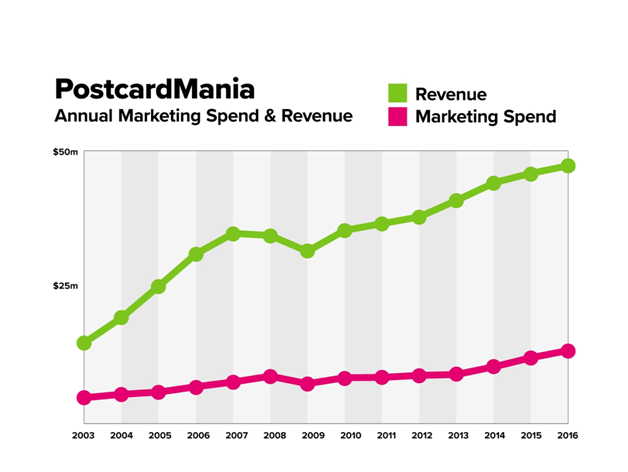3 Lessons Learned from Spending $62 Million on Marketing

I spend around $100,000 per week marketing my company.
Yep, you read that right.
That's JUST marketing PostcardMania to our clients and prospects — with postcards (180,000 per week), Google pay per click advertising, social media and email and salaries.
Obviously...
I didn't spend that much when I first got started. I could have never afforded to!
Back in 1998, when it was just myself and a couple of employees, I sent out 1,000 postcards per week marketing our services.
That's the financial equivalent of $400 (with postcards and postage) today.
Now I have 200+ employees and my company generates nearly $50 million in annual revenue.
And my marketing budget has grown, too — in fact, that's one of the first things I learned...
Lesson #1: Your marketing budget and your revenue growth are inextricably linked.
Your marketing budget should equal a percentage of your gross annual revenue. (What percentage that is depends on your business and goals.)
But that means:
As your revenue grows, so should your marketing budget. That's how I grew my business!
In case you have doubts...
Check out this graph of PostcardMania's real marketing spend and revenue:

Do you see that big dip in revenue in 2009?
Here's what happened:
When the housing bubble burst in 2008, it had a major impact on my business — 46% of my clients at that time were in the real estate and mortgage industry!
For the first time in the history of my company, revenues were down and I needed to cut expenses.
I REFUSED to let any of my staff go, so (against my better judgment) I cut my marketing budget.
You can see how that turned out:
Cutting my marketing budget compounded my revenue loss. BIG mistake.
I won't be doing that again — EVER.
The following year I pumped up my marketing spend and we were back on track!
But then I faced a new challenge...
Lesson #2: You need a unique selling proposition to survive in a competitive industry.
See, when I first started PostcardMania, we were the ONLY company doing what we did:
Dealing directly with small business owners and handling everything — from design to printing to mailing services — in-house.
But now I had copycats popping up EVERYWHERE online.
I needed to do something so that our services wouldn't be just another commodity.
What do I mean by that?
Well, say you need a new blender. You could get that blender (a simple commodity) from anywhere: Walmart, Target, Bed Bath & Beyond, Amazon, etc. And you'll probably get your new blender from wherever is most convenient for you, or wherever you find it for the lowest price.
But, let's say you specifically want the new Vitamix blender that is part blender, part food processor, part stand-up mixer. (This blender is hypothetical and doesn't exist, so don't get too excited.) But that blender is only available directly through Vitamix.
What do you do? Well, if you want that blender, you're going to order it through Vitamix because it isn't just a commodity anymore. It has an added value, which sets it apart.
After more competitors cropped up, I needed to set PostcardMania apart. I couldn't be perceived as a "printer and mailer of postcards."
So I came up with our unique selling proposition (USP). A USP is something that totally sets you apart from your competition.
I hired a full-time results manager whose sole responsibility is to collect data from our clients' campaigns to figure out what makes them successful (or not), so we can share that information with our other clients and prospects.
Today, PostcardMania is the ONLY postcard marketing company to create campaigns based on the results of more than 73,792 small businesses!
The next step was to branch out with our marketing.
Lesson #3: Combining offline and online marketing tools = better return on investment.
The internet not only created challenges for my company, but it also created some awesome opportunities to increase the effectiveness of our own marketing.
We began using call tracking numbers on ALL of our campaigns. Then we were able to clearly see which postcards were pulling for us and which weren't doing so well, so we could tweak those lists and designs.
(Our reception staff STILL fills out a new caller checklist for every lead that calls in so we can add them to our database.)
Just as importantly, if not more so...
We could then listen to the calls that were coming in to hear how those leads were being handled. This has become an invaluable training tool for my company. (For many of my clients, too!)
Knowing that 95% of interested prospects receiving our postcards will visit our website, we also added Google follow-up ads to our marketing mix.
That way, visitors that leave our website without taking action start seeing our follow-up ads all over the internet (on millions of websites across the Google network), reminding them of their interest in us!
What happened was this:
Our results improved so dramatically that we decided to package these services — call tracking and Google follow-up ads, along with mail tracking technology — and start offering them to our clients. (This is the product we call DirectMail2.0, and these days we NEVER run a campaign without it.)
So in case you're wondering...
I do practice what I preach!
I send out postcards every single week and follow up with interested leads with DirectMail2.0 (email too). And last year we brought in our highest-ever revenue!
So there you have it — three things I learned from spending $60+ million on marketing!
 Joy Gendusa is the Founder and CEO of PostcardMania, a fully-integrated marketing firm specializing in direct mail. She literally wrote the book on direct mail (The Ultimate Direct Mail Success Manual!) and offers free samples to all restaurant owners interested in postcard marketing. To claim these freebies, just visit: www.postcardmania.com/go/freesamples Connect with Joy on Google+.
Joy Gendusa is the Founder and CEO of PostcardMania, a fully-integrated marketing firm specializing in direct mail. She literally wrote the book on direct mail (The Ultimate Direct Mail Success Manual!) and offers free samples to all restaurant owners interested in postcard marketing. To claim these freebies, just visit: www.postcardmania.com/go/freesamples Connect with Joy on Google+.


